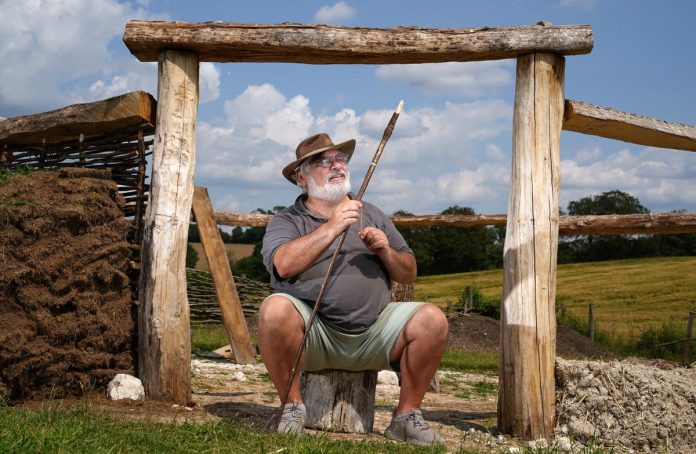m
Military veterans helped with the experimental reconstruction of a Bronze Age roundhouse to learn more about the construction techniques used by our ancestors.
Volunteers recruited through Operation Nightingale are working on the project at Butser Ancient Farm near Chalton, Hampshire to rebuild the building excavated last year at Dunch Hill near Tidworth, Wiltshire.
The Department of Defense launched Operation Nightingale 10 years ago with the aim of helping the recovery of wounded and sick military personnel and veterans through their involvement in archaeological investigations.
Veterans of Operation Nightingale, an initiative supporting the recovery of military personnel, help rebuild the roundhouse (Andrew Matthews / PA) / PA wire
In addition to experimenting with various construction techniques with the aim of determining the most likely method for the original construction 3,000 years ago, the veterans also learned about aspects of Bronze Age life from making pottery to spears.
CONTINUE READING
Archaeologist Claire Walton told PA News Agency, “This project aims to learn more about what houses might have looked like in the Bronze Age and uses recent archaeological evidence to create a full-size experimental construction.
“From the posts in the ground to the thatched roof on the roof, archaeological accuracy is key to a successful outcome, and in fact, the construction was preceded by months of academic discussion and research.
“This project aims to study the construction of the walls that hold the roof – not an easy task when there will be tons of straw overhead.
“Archaeological evidence from famous sites like Danebury Hill Fort suggests that some prehistoric roundhouses had buried earthworks held up by wattle interior walls.
“But not only the participants in the project want to find out whether the technology represents a probable scenario – the academic community is particularly looking forward to documenting the ‘mass’ earth wall technology used here.
“And in running this project, Operation Nightingale not only enjoyed creating a truly unique visitor attraction, but also made a valuable contribution to the ongoing academic debate about how houses were built in the past and what they looked like.”
Jacqui Hutchins, a former RAF administrator from Portsmouth, said the project provided a “fascinating” glimpse into the past.
The 65 year old said, “When we were making the pottery we burned it in a hole in the ground, made a campfire above, but when these pots came out it was so ridiculously exciting, this was a misshapen pot but we had it and we did it like our ancestors did, it was exciting.
The round house is being built on the Butser Ancient Farm in Hampshire (Andrew Matthews / PA) / PA wire
“Once you’ve been in the armed forces and you go away there’s a void, there’s a little hole in your life, so it’s great to be able to talk to like-minded people, there aren’t that many borders,
“It’s a great relief from everyday life, especially in view of the current Covid situation.”
Project Coordinator Trevor Creighton said, “The archeology on which our roundhouse is based was very limited – just evidence of a few post holes spaced around an approximately circular perimeter.
“There is no evidence, not even of walls or a doorway, a fire, broken ceramics or anything else that could tell us how it was built or what it was used for.
“Paradoxically, however, the poorly preserved and limited archeology gives us the opportunity to create something different from all of the existing buildings at Butser Ancient Farm. In fact, few, if any, experimental buildings like ours have been built. “

